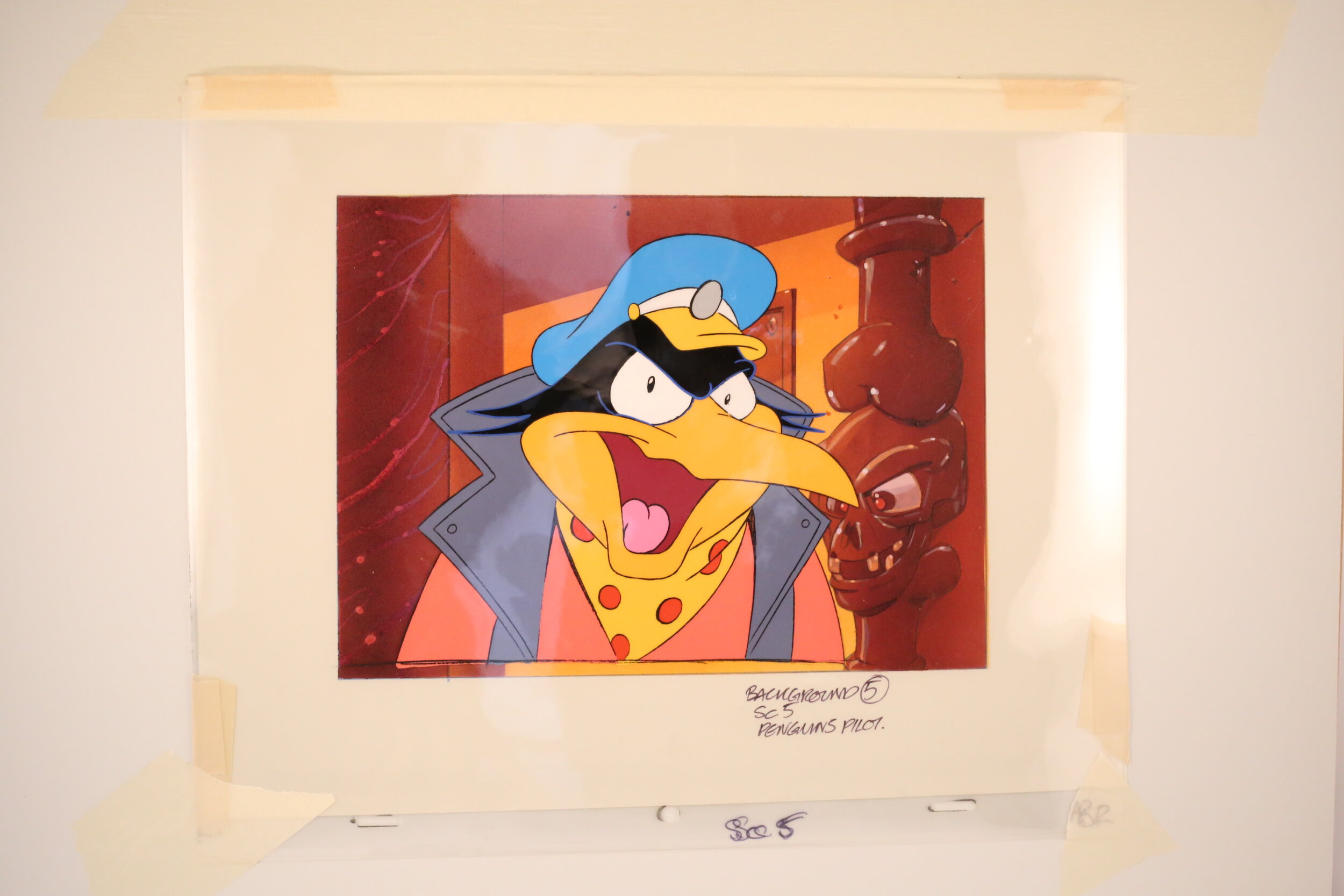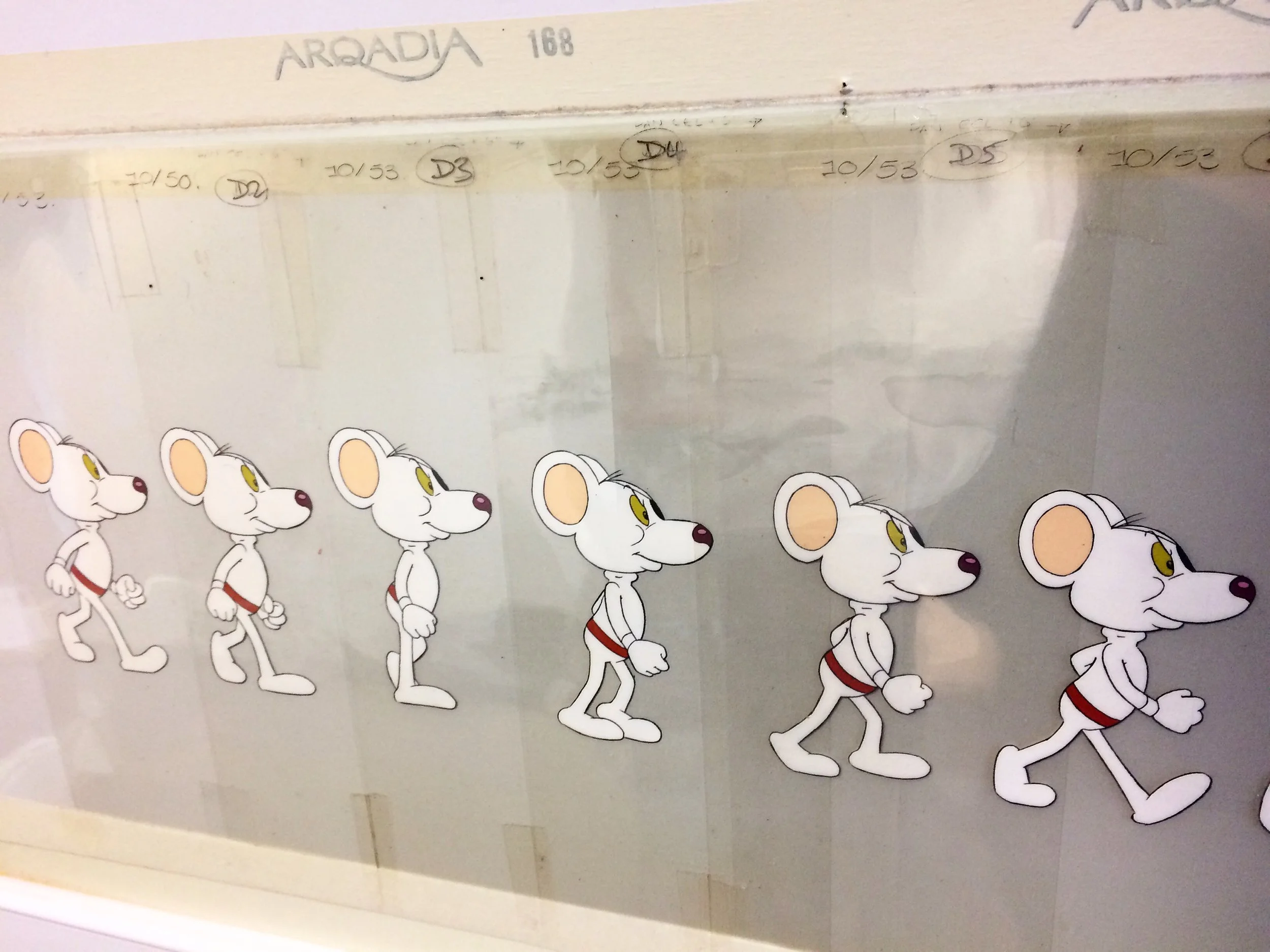Crikey! Understanding and conserving animation cels.
To coincide with Materials in Motion this month our Archive Manager Rosy Whittemore will be looking at the animation cels in the Cosgrove Hall Films Archive, observing some of her findings and reflecting on the complications behind preserving plastics.
In early November Waterside were excited about hosting Steve Henderson, director of Manchester Animation Festival and a whole host of representatives from international animation archives for Materials in Motion. To coincide with this event we’re getting a bit technical, and have drawn together some observations about animation cels within our archive with some discussion about the degradation of plastics mostly used in hand drawn animation. If you’re interested in Stop Motion materials stay tuned because in a future blog post we’ll be tackling some issues surrounding Stop Motion materials in our archive.
Avenger Penguins (Pilot episode, scene 5) animation cels and background
Hand drawn animation was used to create several prolific Cosgrove Hall shows. Danger Mouse, Avenger Penguins and Count Duckula were made using this process. In the archive we have several original Danger Mouse animation cels directly from these series, these were drawn directly onto cellulose acetate. Founders of the studio Mark Hall, Brian Cosgrove and art director Bridget Appleby all worked at Granada Studios before starting their own animation studio. Bridget Appleby worked as a Graphic Designer for Granada Studios and this process would have been done in an analog way. All the credit reels on Television shows were hand drawn, we rarely see this process nowadays as this process is all digitised. Animation is now seen as free form without origins or connections to other fields but there was definitely a cross over and these processes would have influenced each other.
By looking into the process of hand drawn animation, as well as the properties of cellulose acetate you can begin to understand and identify why animators used this medium to animate. Like stop motion, hand drawn animation is a slow and expensive process, with a high quality finish. Within this process the background was often painted separately and moved on a plane, on an opaque piece of paper. The animated figures would then be painted frame by frame, on separate cellulose acetate sheets or ‘cels’, these were overlaid in motion, giving the illusion of movement. When photographed on a lightbox in sequence, often to a rate of 24 frames per second, this gives the appearance of motion. Animating using acetate cellulose is rarely used nowadays, many animation studios who produce 2D animation have now crossed over into producing hand drawn animation digitally, which is faster and more cost effective.
Within our archive observing the properties and processes broadly used by animators, it has helped us to determine and minimise the degradation of plastics in our collection. Cellulose acetate was widely used to paint on the series because of its transparent properties, which means it doesn’t distort the background image and so the motion can be captured seamlessly using a series of acetate cels. Cellulose acetate was also cheap and could sometimes be reused because of its sleek surface.
Advances in plastics production ran concurrently with advances in animation. An interesting study by Kristen Mccormick and Michael R.Schilling describes their research into the degradation of cellulose acetate, tracing the journey of Disney, who used cellulose nitrate in their earliest 1930s animations before transitioning into using cellulose acetate. A material called cellulose nitrate, was commonly used in rolls of film and early animation cels, however this material is highly unstable and degrades at an alarming rate which would suggest there is very little preserved on this material.
In preserving Plastics: An evolving material, a maturing profession by Odile Madden and Tom Learner. The authors explain why plastics seem less secure as a material, one reason could be that the ‘technology is relatively immature’, plastics are relatively new as culturally significant objects. Other materials such as wood seem to be more durable because they’ve survived hundreds of years in collections. This might suggest that preserving plastics is still a relatively new field of research.
Animation cels from Dangermouse, Image Cosgrove Hall Film Archive
At this stage we have no way of positively identifying what Cosgrove Hall Films used without conducting an in depth study with specialist equipment, which could help us capture information such as measuring the hydrolysis within the polymers of the material. What we do know is that it is highly likely that producing series in the 1970s onwards it is highly likely animators would have used acetate cellulose or polyester transparent film. Polyester transparent film was sometimes used by animators, which is chemically more stable and has a higher tensile strength which means it it less likely to break or tear. Luckily, within the archive the majority of our acetate cels and hand drawn animation are in good condition. Minor scratches, dust and fingerprints on the surface and slight damage from bent corners of acetate have been observed. Also residue from adhesive materials, such as tape, which has discoloured has also been noted. Sometimes when a material is destabilised it can cause paint to become sticky, discoloured or flakey. We are relieved that this has not been observed in the Cosgrove Hall Archive, but these are signs to be vigilant about and could be signs of degradation, oxidation, heat exposure or a number of factors.
Within the archive we have taken a preventative course of action to slow the levels of degradation. Acetate is a very flexible material, the paint on the surface has the potential to chip off the surface when the cellulose acetate bends, because of this within the archive we have been keeping the cels as flat as possible. Some of the cels have been mounted which helps to keep these flat, however many of these mounts are broken and need to be reinforced. Where possible we have used foamex boards to keep the cels flat, each acetate animation cel is kept in individual acid free paper folders lined with preservation standard acid free tissue paper so that there is no unstable material directly touching the work. This significantly reduces the risk of contamination. Other measures we have taken is to monitor the temperature and humidity in the spaces, we do not currently have a method for altering the temperature in the spaces, however the store room is dark, has no windows so eliminates the risk of ultraviolet radiation. The temperature is kept as constant as possible, there is no heat or water sources in the space which means the temperature and humidity is as level as possible.
The complication with an animation collection is that animation materials were used for a specific purpose, they were never intended to last. For this reason remediation for these kinds of materials is still a relatively new field of research, we’re excited to learn more and share our findings along the way.
Blog Summary
- Model makers within animation studios used a variety of materials to make more detailed characters for animation.
- Materials used in animation can be sensitive to light, temperature, humidity, ultraviolet radiation in the atmosphere.
- To make sure puppets and hand drawn animation last for years we must take care of them.
- By storing them in special conditions this helps to preserve collections so they last for longer, if not they could gradually get worse.
- To share Cosgrove Hall animations with more people over time we need to take special precautions to ensure they are preserved safely for generations.
Further Reading
Brian Cosgrove, The Cosgrove Hall Story (2018), publisher not identified. Reference copies available at Cosgrove Hall Films Archive and BFI’s Reuben Library.
ANIMATION CELS: Preserving a Portion of Cinematic History, Kristen Mccormick and Michael R. Schilling, Conservation Perspective. Spring 2014, Conservation of Plastics.
Acetate or Polyester? Mechanical Properties and Indicators for Film Stability. Joao Socrates de Oliveira, Bulletin Fiaf, Apr 1993, 46, Performing Arts Periodicals Database pg.39
Conservation Perspectives, Conservation of Plastics, Spring 2014. The Getty Conservation Institute.
Materiology : The Creative Industry's Guide to Materials and Technologies by Daniel Kula, Elodie Ternaux, and Quentin Hirsinger PUBLISHER Walter de Gruyter GmbH DATE 2013-10-14
Smash! Bang! Ka-Pow!, Zahed, Ramin; Zahed, Ramin (correspondence author), Animation Magazine, Mar 2009, Vol.23(3), pp.24-25
POPART: Preservation of Plastic ARTefacts in museum collections [http://popart-highlights.mnhn.fr/]
A SAFE PLACE: Storage Strategies for Plastics BY YVONNE SHASHOUA [http://www.getty.edu/conservation/publications_resources/newsletters/29_1/storage.html]
Slow Disasters: How Neglect Continues to Destroy our Film Heritage, David Walsh.


